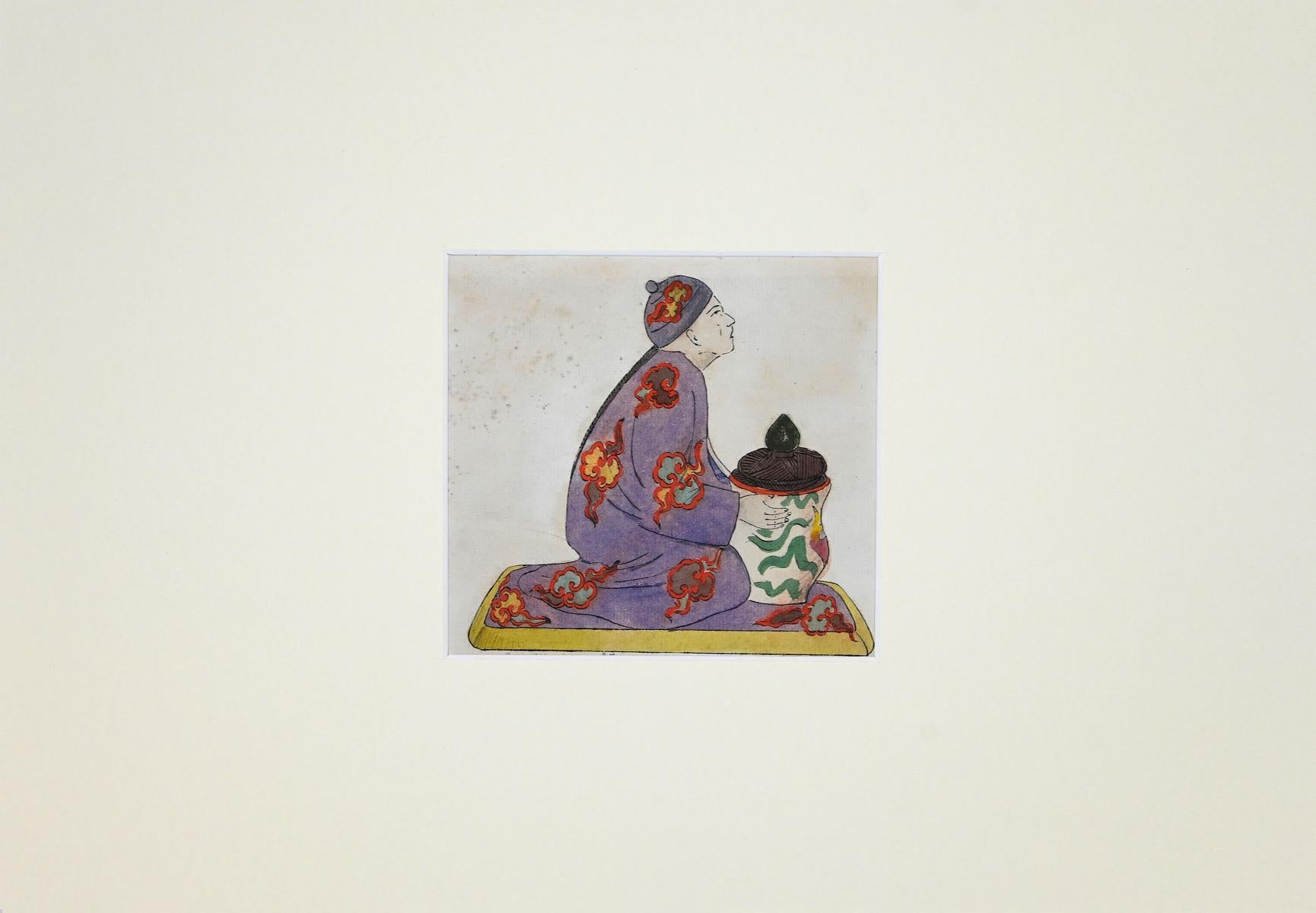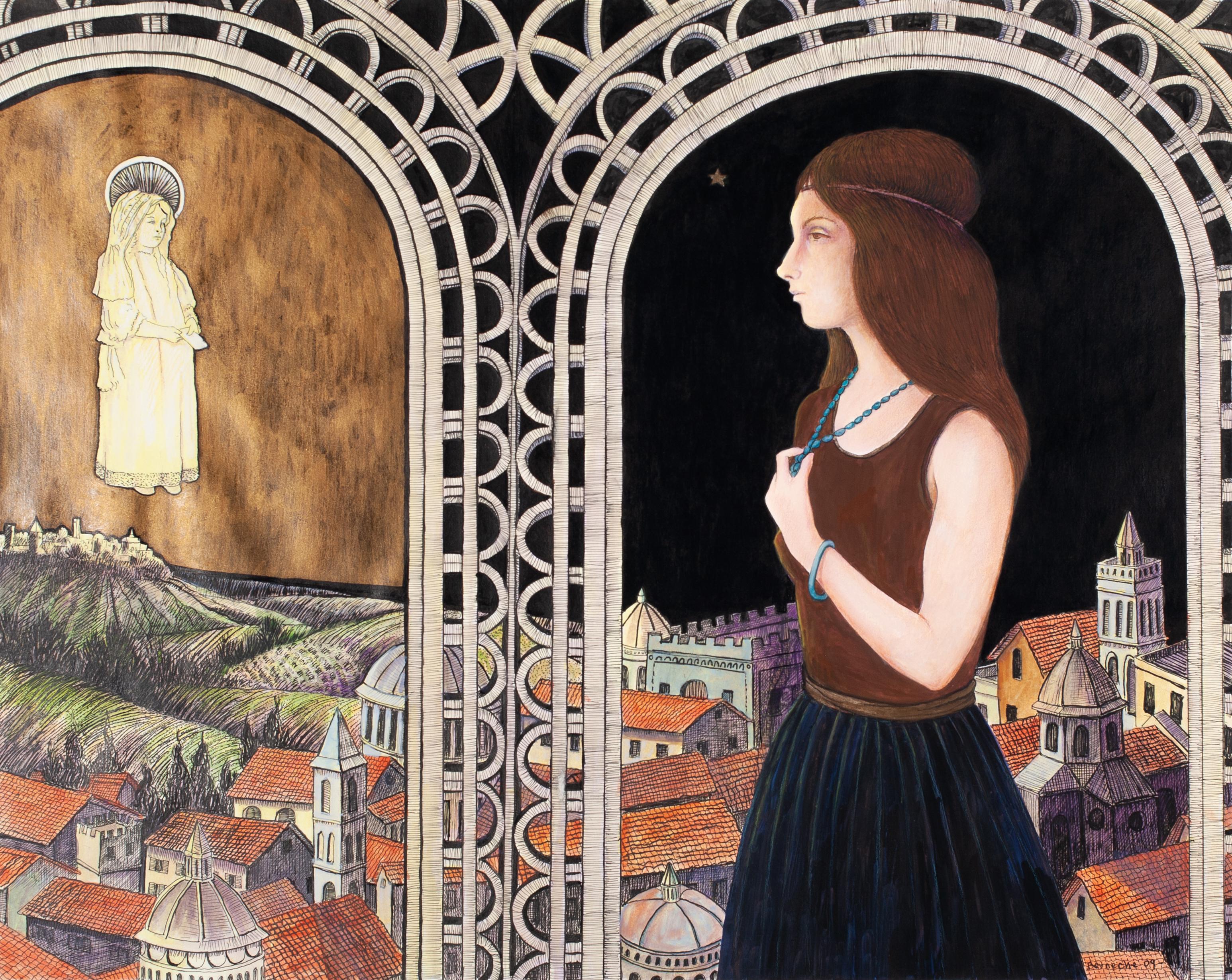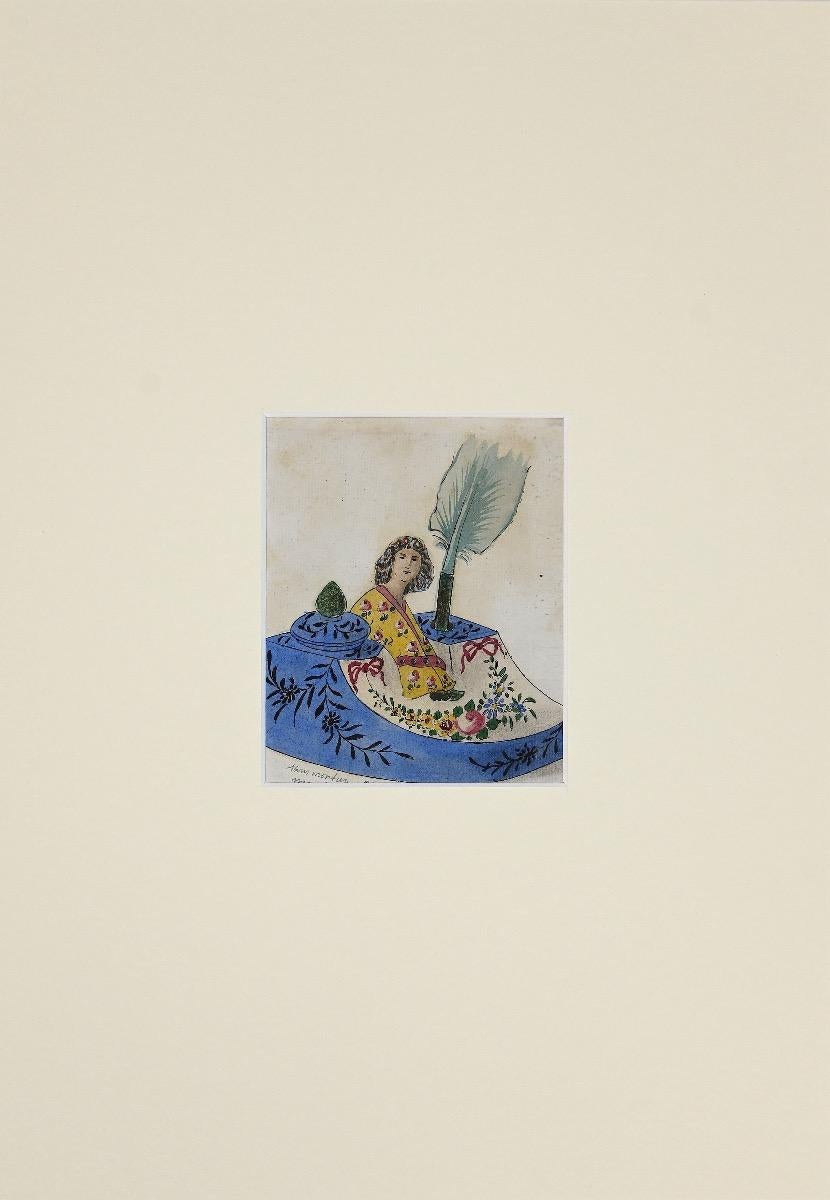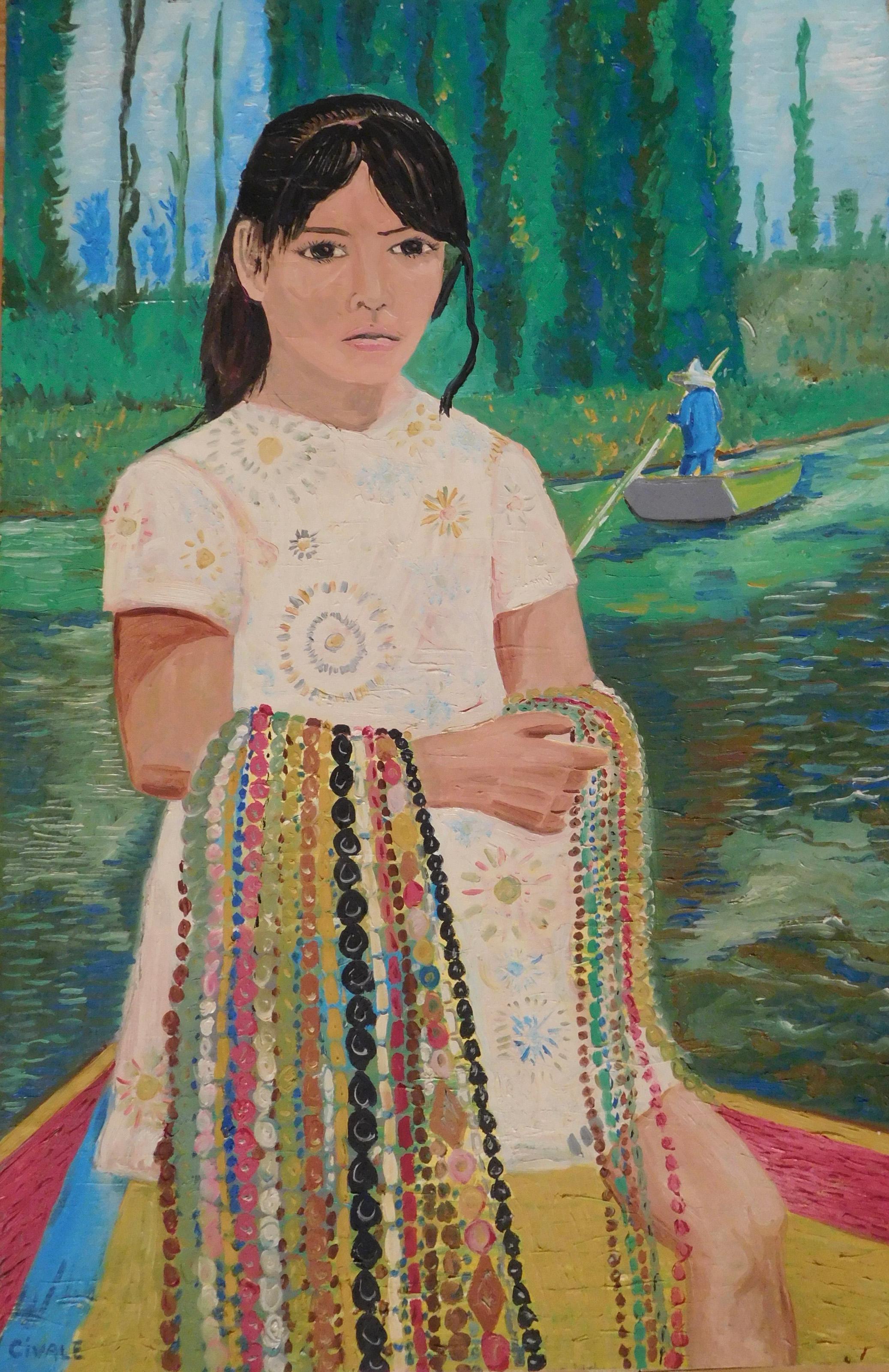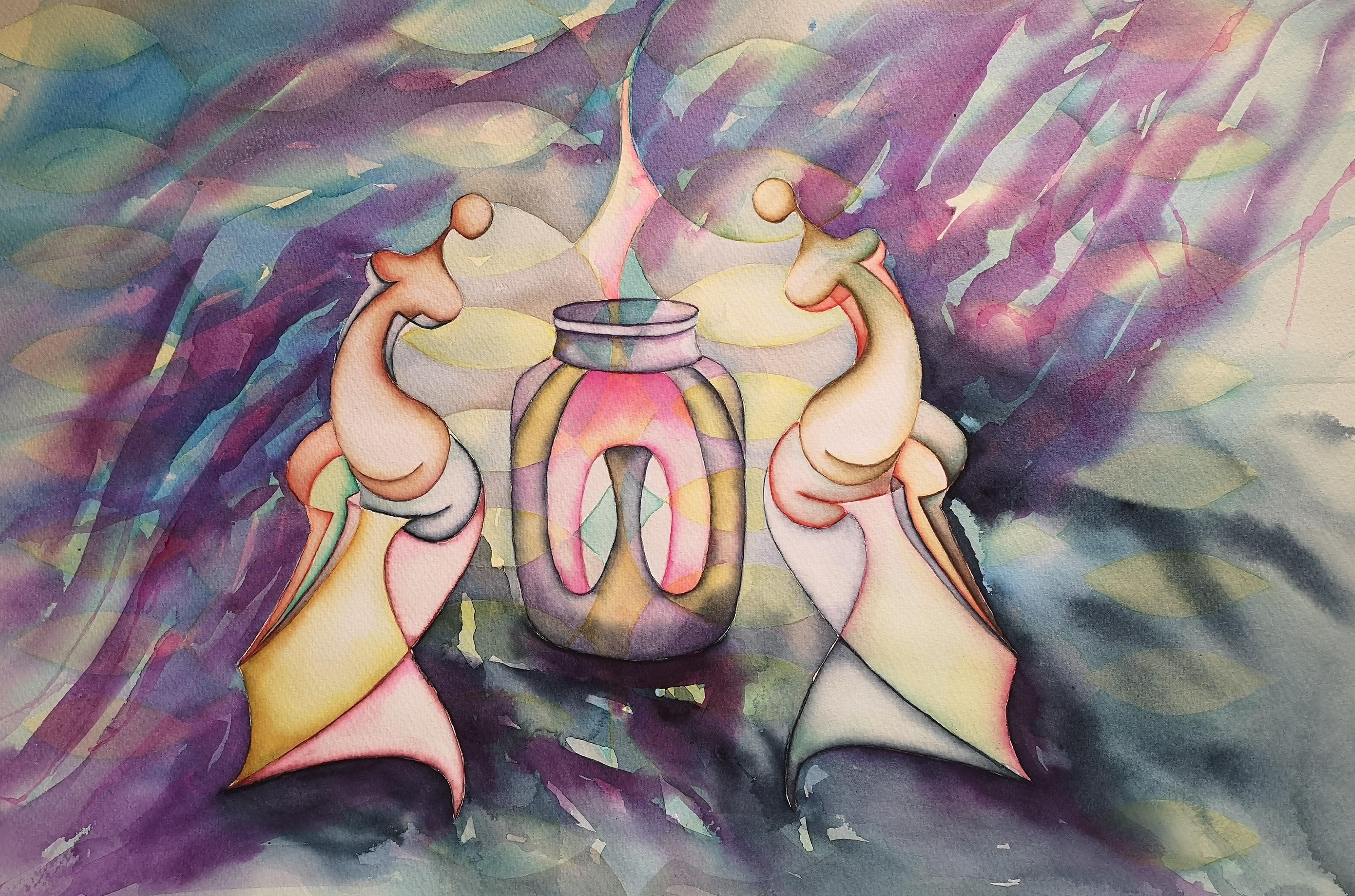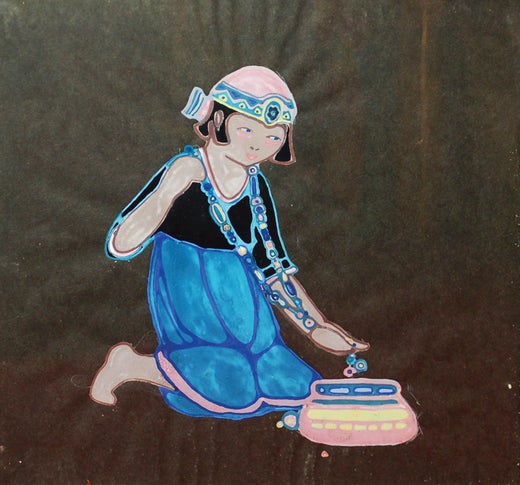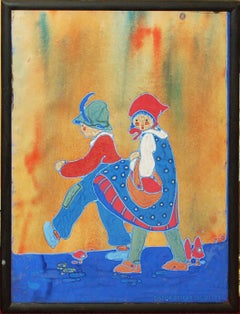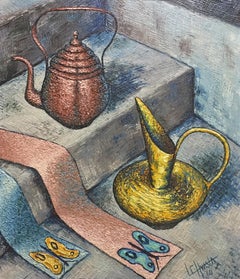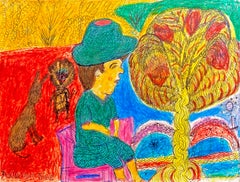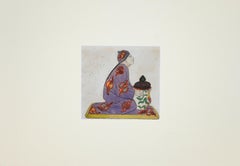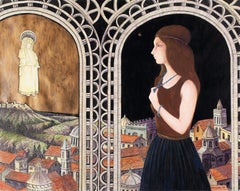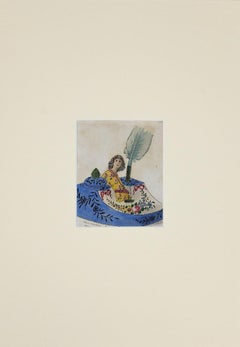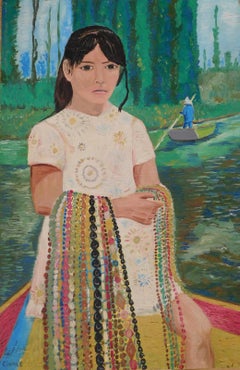Items Similar to The Necklace and the Pot
Want more images or videos?
Request additional images or videos from the seller
1 of 11
Gisella LoefflerThe Necklace and the Potc. 1919
c. 1919
Price Upon Request
Price Upon Request
Price Upon Request
Price Upon Request
Price Upon Request
Price Upon Request
Price Upon Request
Price Upon Request
Price Upon Request
Price Upon Request
About the Item
Gisella Loeffler
"The Necklace and the Pot" c. 1919
Gouache on Paper
Initialed Lower Left
Framed Size: approx 15 x 15 inches
In a village filled with colorful characters, few Taos artists were as colorful as Gisella Loeffler [1900-1977]. From her handmade Austrian clothing and hand-painted furniture to whimsical paintings and letters written in multicolored crayon, joyful color defined the artist, who early on chose to use simply Gisella as her professional name and was known as such to everyone in Taos.
In spite of her fame there—the Taos News once labeled her a Taos legend—Gisella is rarely included in scholarly discussions of the Taos Art Colony. This oversight is likely due to the naive quality of her work, in which children or childlike adults inhabit a simple, brightly colored world filled with happiness. The macabre, the sad, the tortured, the offensive—all have no place in Gisella’s paintings. Her naive style of work looks very different from that of the better-known early Taos artists. Yet both Gisella’s artwork and her interesting life command attention.
Born in Austria, Gisella came to the United States with her family in 1908, settling in St. Louis, MO. After studying art at Washington University in St. Louis, she became a prominent member of the local art community, joining the St. Louis Art Guild as well as the Boston Society of Arts and Crafts. In addition to creating posters for the St. Louis Post Dispatch, Gisella won prizes from the Artists Guild of the Author’s League of America in 1919 and 1920 and from the Kansas City Art Institute in 1923. She also began working in textiles, including batik, to which she would return later in her career.
In the early 1920s Gisella married writer and music critic Edgar Lacher. A difficult character, Lacher may have chafed under Gisella’s success, for the couple divorced in the 1930s.
Having seen a local exhibition of paintings by Taos artists Oscar Berninghaus (who was from St. Louis) and Ernest Blumenschein, Gisella felt drawn to Taos, which reminded her of the villages of her native Austria. In 1933 the single mother with two daughters, Undine and Aithra, moved to Taos, where she lived off and on for the rest of her life. She traveled frequently, spending extended periods in Mexico, South America, and California, but always returned to New Mexico.
Gisella initially applied an Austro-Hungarian folk-art style to the Indian and Hispanic subjects that she found in New Mexico. In her early work she covered her surfaces with decorative floral and faunal motifs, and her images were flat with no attempt at rendering traditional one-point perspective. Eventually, though, Gisella developed her own style, often using children or childlike figures as subjects. Still, the influence of her native country’s folk art remained evident in her New Mexican, Mexican, and South American images.
In 1938 Gisella moved briefly to Los Griegos, north of Albuquerque, to be closer to medical facilities for her eldest daughter, who was suffering from rheumatic fever. Two years later, she moved to California to participate in the war effort, painting camouflage and decals on airplanes for Lockheed.
In California, Gisella broadened her range of artistic pursuits. She taught art privately, created illustrations for Scripts Magazine, and did interior design for private homes. She also designed greeting cards, a practice she continued after her return to New Mexico, where she created a series of Christmas cards.
Gisella began illustrating children’s books in 1941 when she collaborated on Franzi and Gizi with author Margery Bianco. Eventually she wrote and illustrated her own book, El Ekeko, in 1964. She also designed ceramics—her Happy Time Dinnerware, marketed by Poppy Trail and manufactured by Metlox of Manhattan Beach, CA, is highly collectible today.
In 1948 Taos art patron Mabel Dodge Luhan persuaded Gisella and her new husband Frank Chase to return to Taos. The couple lived in the former adobe home of writer D.H. Lawrence and were frequent visitors to the Luhan compound, where Mabel took Gisella into her circle of artist friends. In this environment, the color and joy that were integral to Gisella’s life permeated everything she did, from painting virtually all the surfaces—including the windows—in the Luhan home with bright colors and natural motifs to performing impromptu dances or singing Austrian folk songs with Taos artist Joseph Fleck, a fellow Austrian, at the Luhans’ frequent parties.
Gisella was enchanted by colorful scenes outside of New Mexico as well. In the early 1950s she began visiting South America, where her daughter Undine lived with her husband Ernesto Gutierrez, a U.S. State Department official. First in Bolivia, then in Peru, Gisella was taken with the bright costumes and traditions of the people she encountered. She later patterned much of her handmade clothing after South American costumes seen on these trips. Also intrigued by Mexico, Gisella traveled there as frequently as possible.
Throughout her life, Gisella corresponded regularly with her many friends. Typically her letters were illustrated in crayon or colored pencil with some object or scene from a recent experience. The text of her letters was also written with multiple colors of crayon or colored pencil. A letter from Gisella was always a visual feast.
As a painter, she worked on canvas or paper in oil, casein, and watercolor. She also painted furniture. Besides making her own clothing, Gisella worked in other fabric arts such as batik and embroidery. In fact, she received the top award in fabric arts in 1959 and again in 1967 from the Mus-eum of International Folk Art in Santa Fe. But perhaps Gisella’s greatest legacy is the murals she painted for children’s areas in hospitals across the United States.
Mabel Dodge Luhan may have summed up Gisella’s contributions best when she wrote in her 1947 book Taos and Its Artists: “Gisella Loeffler! How people are attracted to your unny little painted children and the reassuring life you surround them with! This is a real folklore you give us. Everyone is allured and amused by the life of these robust infants with roses and birds and hearts all about them. It makes people forget that sometimes their life is not so gay. These children you paint are very simple and have the sweet peasant charm. Where do you find it? In a faraway Hungarian gypsy grandmother? Or is it really right here beside us all the time, and we too dull and preoccupied with the inconvenience of a mechanical world to be aware of it?”
Gisella’s death in 1977 left a large hole in the fabric of the Taos Art Colony and the entire Taos community. Yet her work, so colorful and full of joy, remains an uplifting presence in Taos.
Michael R. Grauer is curator of art at the Panhandle-Plains Historical Museum in Canyon, TX, which held solo exhibitions for Gisella in the 1950s and ’60s and was the recipient of Gisella’s estate. The museum owns some 30 pieces of her paintings, prints, decorative artworks, and furniture as well as more than 260 illustrated letters.
- Creator:Gisella Loeffler (1902 - 1977, American, Austrian)
- Creation Year:c. 1919
- Dimensions:Height: 15 in (38.1 cm)Width: 15 in (38.1 cm)Depth: 0.5 in (1.27 cm)
- Medium:
- Movement & Style:
- Period:
- Condition:
- Gallery Location:Missouri, MO
- Reference Number:1stDibs: LU74733212483
Gisella Loeffler
Born in Austria, Gisella came to the United States with her family in 1908, settling in St. Louis, MO. After studying art at Washington University in St. Louis, she became a prominent member of the local art community, joining the St. Louis Art Guild as well as the Boston Society of Arts and Crafts. In addition to creating posters for the St. Louis Post Dispatch, Gisella won prizes from the Artists Guild of the Author’s League of America in 1919 and 1920 and from the Kansas City Art Institute in 1923. She also began working in textiles, including batik, to which she would return later in her career. Having seen a local exhibition of paintings by Taos artists Oscar Berninghaus (who was from St. Louis) and Ernest Blumenschein, Gisella felt drawn to Taos, which reminded her of the villages of her native Austria. In 1933 the single mother with two daughters, Undine and Aithra, moved to Taos, where she lived off and on for the rest of her life. She traveled frequently, spending extended periods in Mexico, South America, and California, but always returned to New Mexico. Gisella initially applied an Austro-Hungarian folk-art style to the Indian and Hispanic subjects that she found in New Mexico. In her early work she covered her surfaces with decorative floral and faunal motifs, and her images were flat with no attempt at rendering traditional one-point perspective. Eventually, though, Gisella developed her own style, often using children or childlike figures as subjects. Still, the influence of her native country’s folk art remained evident in her New Mexican, Mexican, and South American images. In California, Gisella broadened her range of artistic pursuits. She taught art privately, created illustrations for Scripts Magazine, and did interior design for private homes. She also designed greeting cards, a practice she continued after her return to New Mexico, where she created a series of Christmas cards. Gisella began illustrating children’s books in 1941 when she collaborated on Franzi and Gizi with author Margery Bianco. Eventually she wrote and illustrated her own book, El Ekeko, in 1964. She also designed ceramics—her Happy Time Dinnerware, marketed by Poppy Trail and manufactured by Metlox of Manhattan Beach, CA, is highly collectible today. As a painter, she worked on canvas or paper in oil, casein, and watercolor. She also painted furniture. Besides making her own clothing, Gisella worked in other fabric arts such as batik and embroidery. In fact, she received the top award in fabric arts in 1959 and again in 1967 from the Mus-eum of International Folk Art in Santa Fe. But perhaps Gisella’s greatest legacy is the murals she painted for children’s areas in hospitals across the United States. Gisella’s death in 1977 left a large hole in the fabric of the Taos Art Colony and the entire Taos community. Yet her work, so colorful and full of joy, remains an uplifting presence in Taos.
About the Seller
5.0
Vetted Professional Seller
Every seller passes strict standards for authenticity and reliability
Established in 1970
1stDibs seller since 2017
155 sales on 1stDibs
Typical response time: Several days
- ShippingRetrieving quote...Shipping from: Missouri, MO
- Return Policy
Authenticity Guarantee
In the unlikely event there’s an issue with an item’s authenticity, contact us within 1 year for a full refund. DetailsMoney-Back Guarantee
If your item is not as described, is damaged in transit, or does not arrive, contact us within 7 days for a full refund. Details24-Hour Cancellation
You have a 24-hour grace period in which to reconsider your purchase, with no questions asked.Vetted Professional Sellers
Our world-class sellers must adhere to strict standards for service and quality, maintaining the integrity of our listings.Price-Match Guarantee
If you find that a seller listed the same item for a lower price elsewhere, we’ll match it.Trusted Global Delivery
Our best-in-class carrier network provides specialized shipping options worldwide, including custom delivery.More From This Seller
View AllGoing for a Stroll
By Gisella Loeffler
Located in Missouri, MO
Gisella Loeffler
"Going for a Stroll" c. 1919
Gouache on Paper
Initialed
Framed Size: approx 17 x 13 inches
In a village filled with colorful characters, few Taos artists were as colorful as Gisella Loeffler [1900-1977]. From her handmade Austrian clothing and hand-painted furniture to whimsical paintings and letters written in multicolored crayon, joyful color defined the artist, who early on chose to use simply Gisella as her professional name and was known as such to everyone in Taos.
In spite of her fame there—the Taos News once labeled her a Taos legend—Gisella is rarely included in scholarly discussions of the Taos Art Colony. This oversight is likely due to the naive quality of her work, in which children or childlike adults inhabit a simple, brightly colored world filled with happiness. The macabre, the sad, the tortured, the offensive—all have no place in Gisella’s paintings. Her naive style of work looks very different from that of the better-known early Taos artists. Yet both Gisella’s artwork and her interesting life command attention.
Born in Austria, Gisella came to the United States with her family in 1908, settling in St. Louis, MO. After studying art at Washington University in St. Louis, she became a prominent member of the local art community, joining the St. Louis Art Guild as well as the Boston Society of Arts and Crafts. In addition to creating posters for the St. Louis Post Dispatch, Gisella won prizes from the Artists Guild of the Author’s League of America in 1919 and 1920 and from the Kansas City Art Institute in 1923. She also began working in textiles, including batik, to which she would return later in her career.
In the early 1920s Gisella married writer and music critic Edgar Lacher. A difficult character, Lacher may have chafed under Gisella’s success, for the couple divorced in the 1930s.
Having seen a local exhibition of paintings by Taos artists Oscar Berninghaus (who was from St. Louis) and Ernest Blumenschein, Gisella felt drawn to Taos, which reminded her of the villages of her native Austria. In 1933 the single mother with two daughters, Undine and Aithra, moved to Taos, where she lived off and on for the rest of her life. She traveled frequently, spending extended periods in Mexico, South America, and California, but always returned to New Mexico.
Gisella initially applied an Austro-Hungarian folk-art style to the Indian and Hispanic subjects that she found in New Mexico. In her early work she covered her surfaces with decorative floral and faunal motifs, and her images were flat with no attempt at rendering traditional one-point perspective. Eventually, though, Gisella developed her own style, often using children or childlike figures as subjects. Still, the influence of her native country’s folk art remained evident in her New Mexican, Mexican, and South American images.
In 1938 Gisella moved briefly to Los Griegos, north of Albuquerque, to be closer to medical facilities for her eldest daughter, who was suffering from rheumatic fever. Two years later, she moved to California to participate in the war effort, painting camouflage and decals on airplanes for Lockheed.
In California, Gisella broadened her range of artistic pursuits. She taught art privately, created illustrations for Scripts Magazine, and did interior design for private homes. She also designed greeting cards, a practice she continued after her return to New Mexico, where she created a series of Christmas cards.
Gisella began illustrating children’s books in 1941 when she collaborated on Franzi and Gizi with author Margery Bianco. Eventually she wrote and illustrated her own book, El Ekeko, in 1964. She also designed ceramics—her Happy Time Dinnerware, marketed by Poppy Trail...
Category
1910s Modern Figurative Drawings and Watercolors
Materials
Gouache
Price Upon Request
Still Life with Butterfly Sash
Located in Missouri, MO
Still Life with Butterfly Sash by Louis Carl Hvasta (1913-1993)
Unframed: 28" x 24"
Framed: 35" x 31"
Signed and Dated Lower Right
A local Californian Artist, Hvasta is largely sel...
Category
20th Century American Impressionist Still-life Paintings
Materials
Oil, Panel
Price Upon Request
A Beautiful Day
By Nellie Mae Rowe
Located in Missouri, MO
A Beautiful Day, 1978
by Nellie Mae Rowe (American, 1900-1982)
Unframed: 9" x 12"
Framed: 11.25" x 14.25"
Signed and Dated Lower Left
Nellie Mae Rowe ...
Category
20th Century Folk Art Abstract Drawings and Watercolors
Materials
Crayon, Pastel, Paper, Graphite
Price Upon Request
Golf Bags, Caddy with Golf Bag on His Back
By Frederick Conway
Located in Missouri, MO
Framed Size: approx 17 3/4 x 20 3/4 inches
Fred Conway (1900-1973)
"Golf Bags, Caddy with Golf Bag on His Back"
Pen/Ink/Watercolor on Paper
Site Size: approx. 10 x 13 inches
Framed Size: approx. 17 3/4 x 20 3/4 inches
A member of the faculty of the Washington University Art School from 1929 to 1970, Frederick Conway...
Category
1960s American Modern Figurative Drawings and Watercolors
Materials
Paper, Ink, Watercolor, Pen
Medicine Man
By Cassilly Adams
Located in Missouri, MO
Cassilly Adams (American 1843-1921)
"Medicine Man" c. 1860s
Watercolor on Paper
Unsigned
Provenance: Questroyal Gallery, NYC
Site Size: approx. 14.5 x 8....
Category
Mid-19th Century American Realist Figurative Drawings and Watercolors
Materials
Paper, Watercolor
Price Upon Request
Summer Still Life, Wine, Melons and Fruit
By Henry Lee McFee
Located in Missouri, MO
Summer Still Life, Wine, Melons and Fruit
Henry Lee McFee (American, 1886-1953)
Watercolor on Paper
Signed Lower Right
14 x 19 inches
22.75 x 28.75 inches with frame
Henry Lee McFee...
Category
20th Century Cubist Still-life Drawings and Watercolors
Materials
Watercolor, Paper
You May Also Like
Porcelain Inkwell - Original Ink and Watercolor Drawing - 1890 ca.
Located in Roma, IT
Porcelain Inkwell is an original china ink and watercolor drawing on ivory-colorated paper by realized in 1890 ca. Anonymous Artist of the late 19th Century.
In very good conditions...
Category
Late 19th Century Modern Figurative Drawings and Watercolors
Materials
Paper, Ink, Watercolor
The Necklace
Located in Columbia, MO
Jerry Berneche (1932 - 2016) was a painter and draftsman of representational scenes and portraits featuring extraordinary color work and extremely detailed mark-making. Locally he is...
Category
20th Century American Realist Figurative Drawings and Watercolors
Materials
Watercolor, Ink
Porcelain Inkwell - Original Ink and Watercolor Drawing - 1890s
Located in Roma, IT
Porcelain inkwell is an original china ink and watercolor drawing on ivory-colorated paper by realized in 1890 ca. Anonymous Artist of 19th Century.
In very good conditions.
The ar...
Category
19th Century Modern Figurative Drawings and Watercolors
Materials
Paper, Watercolor, Ink
Girl Selling Necklaces, Modern Oil on Board by Biagio Civale
Located in Long Island City, NY
Biagio Civale, Italian/American (1936 - ) - Girl Selling Necklaces, Year: circa 1975, Medium: Oil on Board, signed l.l., Size: 36 x 24 in. (91.44 x 60.96 cm), Description: Starin...
Category
1970s Modern Portrait Paintings
Materials
Oil
Girl. Paper/watercolor. 64x50 cm
Located in Riga, LV
Girl. Paper/watercolor. 64x50 cm
Malda Muizule
Malda Muižule was born in 1937 in the family of a blacksmith. Graduated from Liepāja Applied Arts High School (1957). She continued he...
Category
Late 20th Century Post-Modern Figurative Drawings and Watercolors
Materials
Paper, Watercolor
$719 Sale Price
20% Off
"Magic recipe" Original surrealistic watercolour painting . Wall decor
Located in Oslo, NO
The picture describes creative people looking for a recipe for happiness. The artist uses impossible figures in the painting that enhance the arsthetic effect.
This motive will refresh any interior. High-quality materials were used for work.
The gallery guarantees the uniqueness and high quality of this work of art, confirmed by purchasing paintings by Sanne Bleka...
Category
2010s Futurist Figurative Drawings and Watercolors
Materials
Paper, Watercolor
